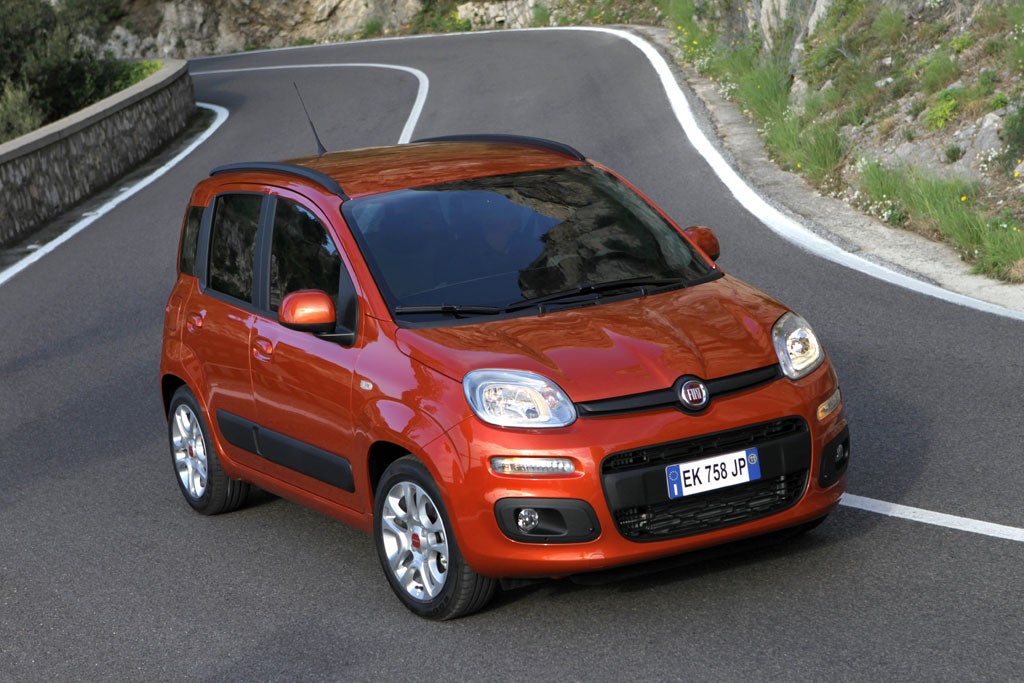Fiat Panda Twinair Lounge
Why Fiat's new Panda can give VW's compact a run for its money

Your support helps us to tell the story
From reproductive rights to climate change to Big Tech, The Independent is on the ground when the story is developing. Whether it's investigating the financials of Elon Musk's pro-Trump PAC or producing our latest documentary, 'The A Word', which shines a light on the American women fighting for reproductive rights, we know how important it is to parse out the facts from the messaging.
At such a critical moment in US history, we need reporters on the ground. Your donation allows us to keep sending journalists to speak to both sides of the story.
The Independent is trusted by Americans across the entire political spectrum. And unlike many other quality news outlets, we choose not to lock Americans out of our reporting and analysis with paywalls. We believe quality journalism should be available to everyone, paid for by those who can afford it.
Your support makes all the difference.Price: Range from £8,700-£12,500
Engine: 875cc, two cylinders, 8 valves, turbo, 85bhp
Transmission: Five-speed gearbox, front-wheel drive
Performance: 110mph, 0-62 in 11.2sec, 67.3mpg official average, CO2 99g/km
Fiat 500s are everywhere. In the UK they outsell all other Fiats put together, thanks to an irresistible blend of compactness, chicness and retro appeal. The practical but puritanical Panda, meanwhile, has faded into the background – yet, objectively, it has always been more of a car for doing the things cars should do.
Three decades ago the original Panda was a kind of Italian, updated Citroën 2CV, with its flat windows, aura of simple utility and fabric-trimmed, open-plan cabin. Its 2003 replacement was more sophisticated but kept to the functional ethos. Now, here's a new one.
Its shape is clearly derived from the previous cars', as are the structure and mechanical make-up – much of which the 500 also shares. So it's a tall car with a near-vertical tail, five doors and a high driving position – almost a small MPV. But the angular rationality has been softened with curvaceous flanks, a wider stance and rounded extremities.
And the whole look has been recast in a smiley-face, cartoonish way, with rounded-edge squares and rectangles as the motif outside and in. You'll find them on the air intakes and the shapes of the wheel arches, in the outlines of the instruments, the switch panels, the centre of the steering wheel and even, if you follow the line of the seam thereon, the steering wheel itself. Don't worry, the rim is circular, not a reprise of the Austin Allegro's much-mocked Quartic helm.
More squares, embossed and varied in size, adorn the faces of the seats' backrests to help air circulate between your back and the seat, while the open storage bin in the dashboard is meant to hark back to the original Panda "pouch".
Options include a sliding rear seat to enlarge the boot's volume, but even with the seat in its normal position, rear passengers have less legroom than in the Panda's sternest rival, the Volkswagen Up. That said, this is a roomier Panda than before thanks to thinner front seat-backs and more shoulder width.
The increased visual sophistication is matched by the driving qualities. But before going anywhere I sampled the new heater system's claimed ability to demist the windscreen more efficiently, thanks to a colossal downpour. View swiftly restored, I let off the handbrake, which looks like a computer mouse with a button in the side, and set off. Four engines are offered: a 1.2-litre petrol unit with 69bhp, a 1.3-litre turbodiesel with 75bhp, and a pair of two-cylinder Twinair engines rated at a tax-friendly 99g/km CO2. One has a 964cc capacity and produces 65bhp; the other is familiar from the 500 and uses a turbocharger to generate a healthy 85bhp from 875cc.
This last is the most interesting and powered the car – in top Lounge trim rather than lowlier Pop or Easy – that I drove. Straight away this Twinair feels crisp and punchy, more so than in the 500 thanks to a recalibrated, sharper response to the accelerator as it liberates the deep, intriguing, two-cylinder thrum that suits the Panda's personality so well.
The way this Panda moves along the road is a world away from the previous one. The wider wheel track, plus softer rubber in the suspension pivots and noise-isolating upper mounts for the front struts, keep it flat and more precise in the corners while soaking up bumps with a whole new quietness. It's a more civilised machine – yet more fun to drive.
Here, then, is the Panda as cool gadget, leaving the fashion-accessory role to its dearer 500 sibling. Sense with sensibility. Sounds ideal to me.
Join our commenting forum
Join thought-provoking conversations, follow other Independent readers and see their replies
Comments